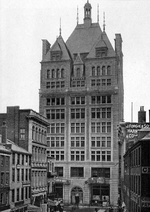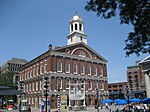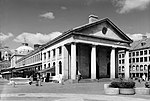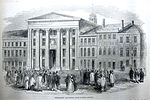Merchants Row (Boston)
Economic history of BostonFinancial District, BostonHistory of BostonStreets in Boston

Merchants Row in Boston, Massachusetts is a short street extending from State Street to Faneuil Hall Square in the Financial District. Since the 17th century it has been a place of commercial activity. It sits close to Long Wharf and Dock Square, hubs of shipping and trade through the 19th century. Portions of the street were formerly known as Swing-Bridge Lane, Fish Lane, and Roebuck Passage.
Excerpt from the Wikipedia article Merchants Row (Boston) (License: CC BY-SA 3.0, Authors, Images).Merchants Row (Boston)
Merchants Row, Boston
Geographical coordinates (GPS) Address Nearby Places Show on map
Geographical coordinates (GPS)
| Latitude | Longitude |
|---|---|
| N 42.359494444444 ° | E -71.055708333333 ° |
Address
India Building
Merchants Row 10
02109 Boston
Massachusetts, United States
Open on Google Maps










